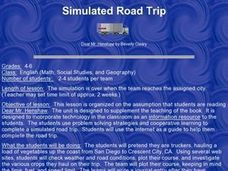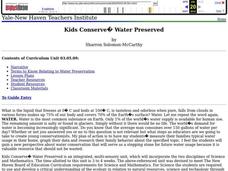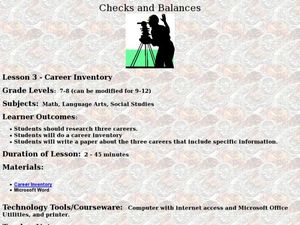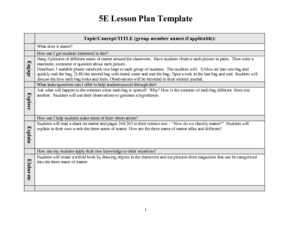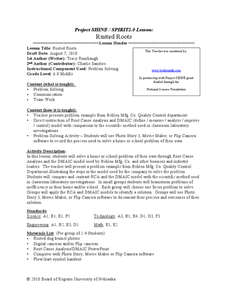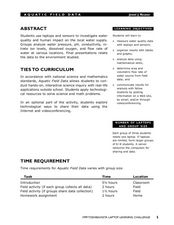Curated OER
How Light Travels
Students conduct an experiment. For this light lesson, students work in groups to see how light travels in a straight line and how light reflects.
Curated OER
Vector Voyage!
Learners use vector analysis to examine the concept of dead reckoning. They listen to a teacher-led lecture, complete a Vector Voyage Worksheet with the teacher, answer discussion questions, and use the Pythagorean Theorem for speed...
Curated OER
Going the Distance
Students experiment in small groups to answer the question, "Is there a relationship between ramps and speed?" They apply a formula to calculate the speed of the cars used in the experiment, complete the associate lab report, and...
Curated OER
Dripping Wet or Dry as a Bone?
Students use a sponge and water model to explore the concept of relative humidity and create a percent scale. They define humidity and saturation, build a simple humidity/saturation model, collect, predict and interpret data, and create...
Curated OER
Simulated Road Trip
Students read the book, DEAR MR. HENSHAW. They implement problem solving strategies and cooperative learning to complete a simulated road trip. Students will use the Internet as a guide to help them complete the road trip.
Curated OER
Beginning with Bosch
Young scholars explore surrealism through the artwork of Hieronymus Bosch. In this surrealism instructional activity, students understand the characteristics of the art of Bosch and create an original artwork and poem to go with it.
Curated OER
Climb Every Volcano
Middle schoolers use a contour map to distinguish the elevation of a volcano. In this volcano instructional activity, students use styrofoam to create the contour of their map. Middle schoolers glue and assemble their...
Curated OER
Environment: Battling for Oxygen
Students construct an interactive ozone depletion model using gumdrops and toothpicks. After analyzing the data obtained from the model, they record it on butcher paper and complete worksheets about oxygen.
Curated OER
Understanding: Computing
Students examine how a pebble calculator works and compare it to an abacus. After a discussion on the abacus and pebble calculator and how each works, they construct their own pebble calculators. They determine how to represent...
Curated OER
Kids Conserve? Water Preserved
Middle schoolers study conservation and how cities obtain their water. In this water instructional activity students view a PowerPoint presentation and draw a picture of the water cycle.
Curated OER
Floating and Falling Flows
Students discover fluid dynamics related to buoyancy through experimentation and optional photography. Using one set of fluids, they make light fluids rise through denser fluids. Using another set, they make dense fluids sink through a...
Curated OER
Smart Move!
Students visualize a communication system. They encode, decode, transmit, receive and store messages. Students use a code sheet and flashlight for this process. They will also maintain a storage sheet from which they can retrieve...
Curated OER
The Westward Movement
Students study the westward movement through examining stamps. For this westward movement lesson plan, students draw conclusions, determine cause and effect relationships and examine the westward movement of the United States by...
Curated OER
Plants and Animals, Partners in Pollination
Students participate in multiple hands-on activities to explore reproduction and pollination. In groups, using a cotton swab and powder, students simulate being pollinators and plants. They name the parts of the flowers and the function...
Curated OER
Career Inventory
Students research three careers and write an essay in which they give specific information about each. In this career lesson plan, students use career finder to discover information about three careers. Students will discuss each career...
Curated OER
What's My Rule? Simple Linear Functions
Young scholars investigate simple linear functions by trying to guess a function rule from inputs and outputs. They write the function rule in algebraic form.
Curated OER
What Does It Matter?
Young scholars match definitions with vocabulary words and learn basic facts about matter. Then, they see how to determine the physical characteristics of matter. They determine the mass, volume, and density of objects using appropriate...
Curated OER
Tree I.D.
Students explore various tree species. In this tree species lesson, students collect leaves on nature walks and use Internet sources to identify the trees that the leaves belong to. Students graph their data as well.
Curated OER
Do Plants Eat?
Students explain that photosynthesis is a process that plants use to convert light energy into glucose. They summarize photosynthesis as a chemical process in which the plant uses carbon dioxide and water to form glucose and oxygen.
Curated OER
Rusted Roots
Students create a flowchart on the root cause method. In this inquiry lesson, students compare RCA and the DMAIC model with the scientific method of problem solving. They investigate a problem in school and present their findings in class.
Curated OER
From Sunlight to Electric Current
Students explore concept of current in electrical circuits. They examine how energy from the sun can be used to power everyday items, including vehicles.
Curated OER
Aquatic Field Data
Students use laptops and sensors to measure water quality and graph their results. In this aquatics activity students post their results to a website or email.
Curated OER
The No Zone of Ozone
Students explore the causes and effects of the Earth's ozone holes through discussion and an interactive simulation. Using gumdrops and toothpicks, they conduct a large-group, interactive ozone depletion model.
Curated OER
Visit My Class Wikis
Students visit the links on the blog site to learn about class wikis. In this technology integration lesson, students visit the links to view class wikis.




